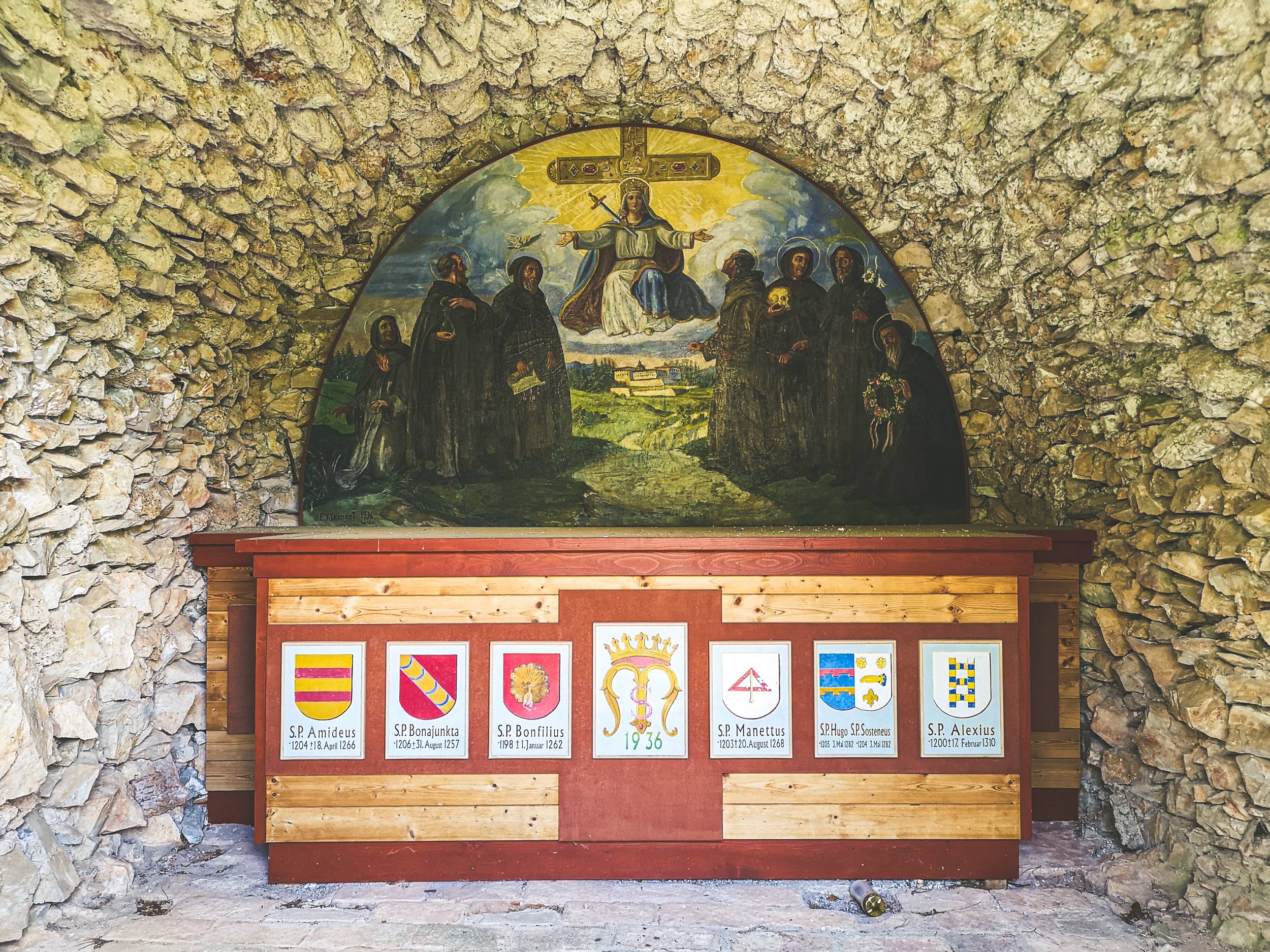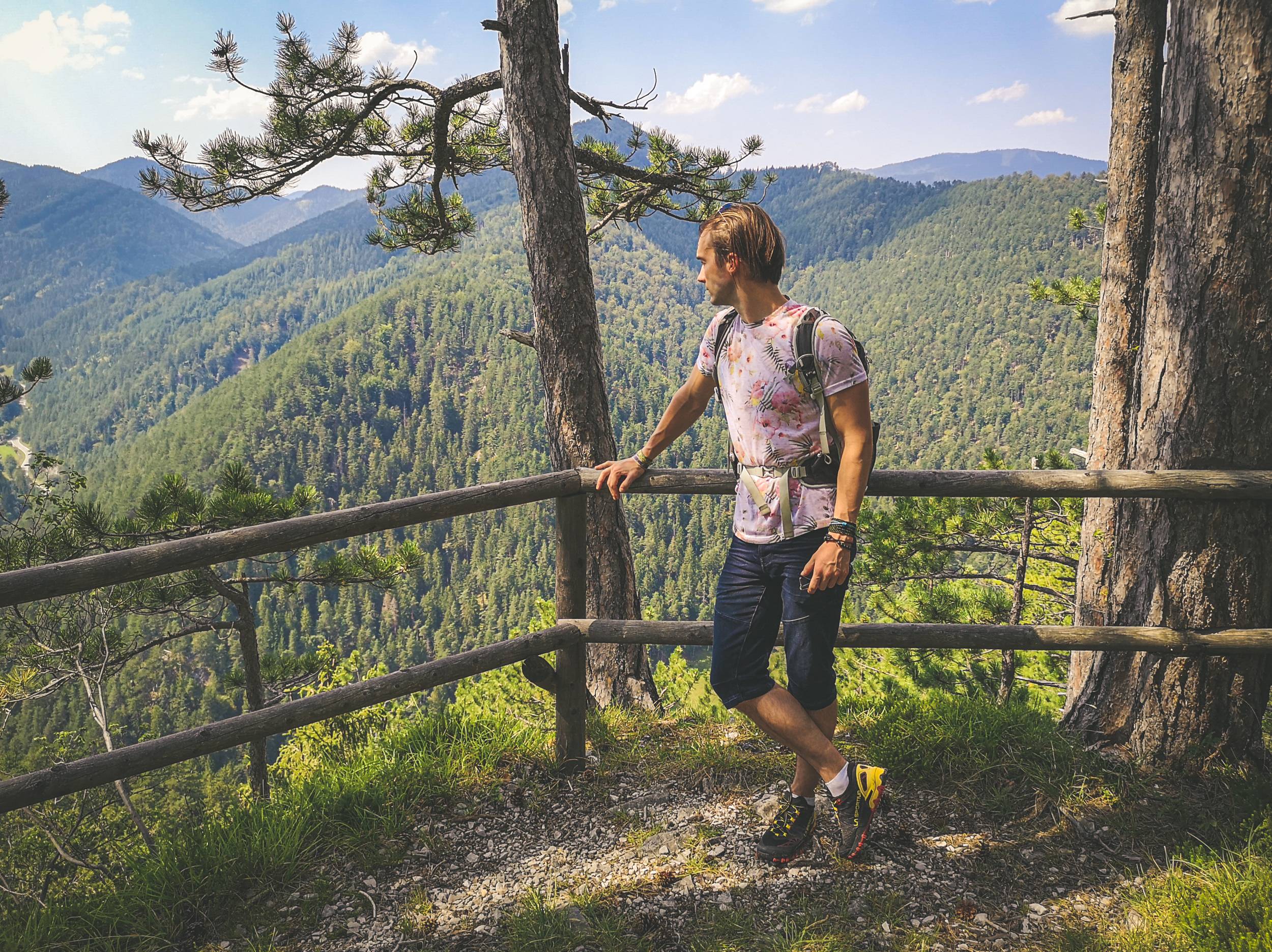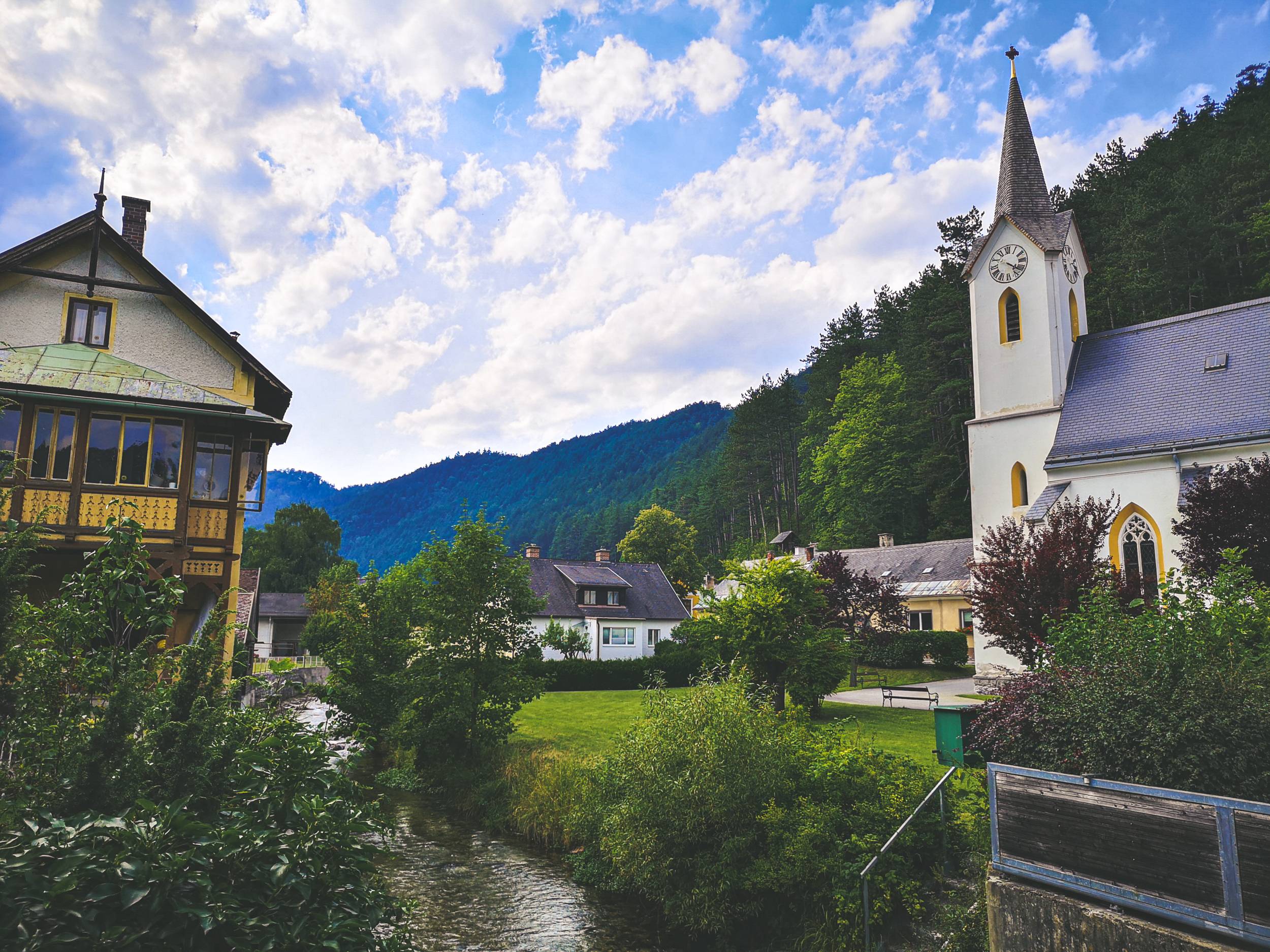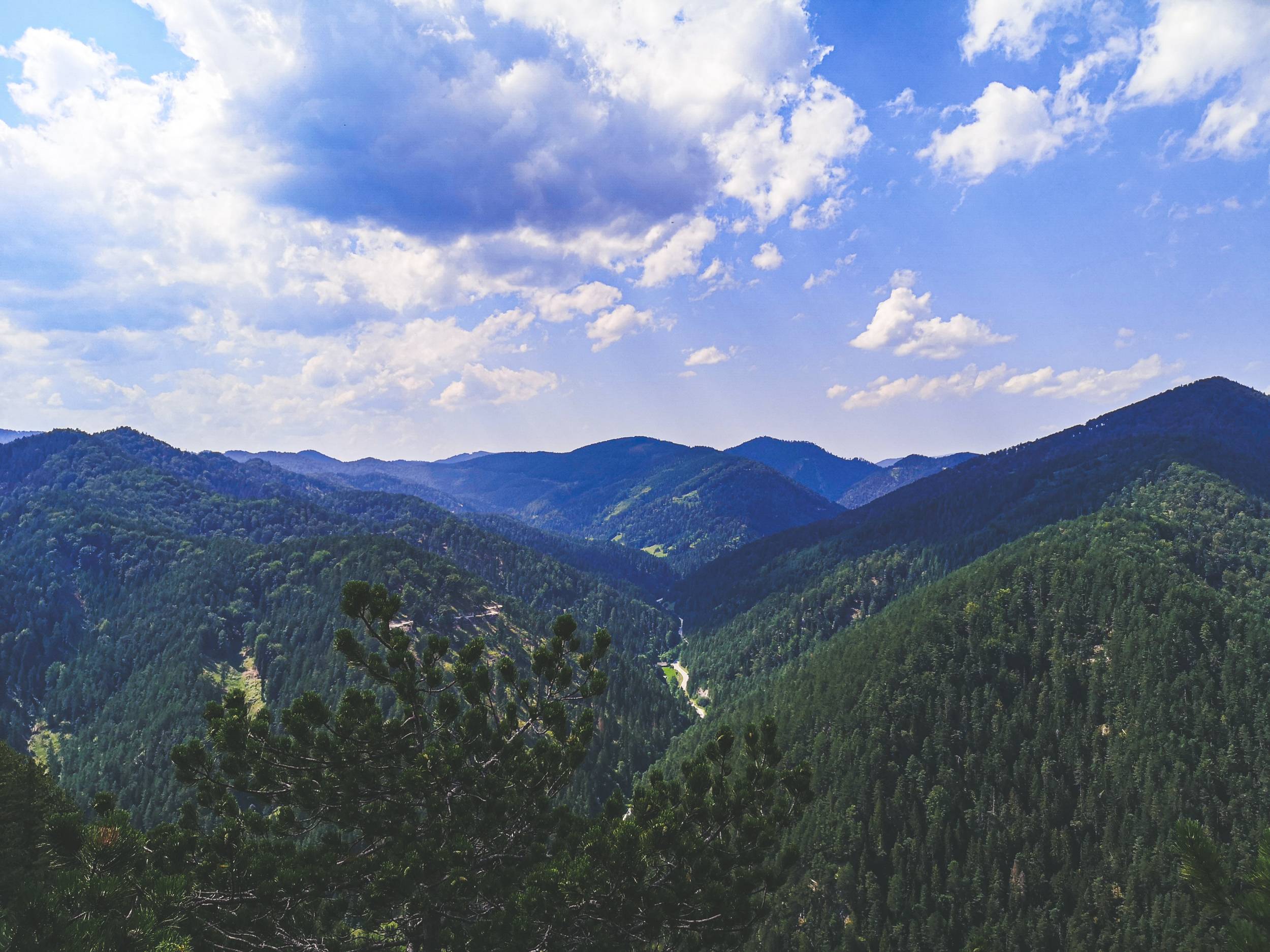August 14, 2020
Gutenstein Guide to Hiking in Alps & Mariahilfberg
Active life, Culture, Guide, History
Top attractions:
Quick Navigation
Gutenstein Alps
Located in Lower Austria, Gutenstein Alps borders the majority of the most beautiful regions of the state. It is separated by different valleys from Vienna Woods in the north, Vienna Basin in the east, Rax-Scheeberg mountain group in the south, and Türnitz Alps in the west. Despite the impressive list, the green hills and mountains of Gutenstein Alps are far from being overshadowed by its neighbors, this mountain group brings its own distinctive taste to the Lower Austria.

Throughout the centuries, the beauty of Gutenstein inspired many artists. Photo by Alis Monte [CC BY-SA 4.0], via Connecting the Dots
Gutenstein Town
Named after the region of the Alps, the town is situated at the very heart of the Gutenstein Alps in the Piesting valley. For centuries, the breath-taking landscape surrounding the town attracted and inspired various artists, including Ferdinand Raimund who declared Gutenstein as his home.
For such a small town: two castles, two churches, parish, theater, pool, and monastery sounds rather impressive. But all of that are just dry numbers, the actual charm of this cozy town could be only fully appreciated with your own eyes.

Church of St. John the Baptist has inscribed the Chronicles of Gutenstein on its wall. Photo by Alis Monte [CC BY-SA 4.0], via Connecting the Dots
Once you get used to the Rax-Schneeberg mountain group, Gutenstein adds something fresh to the Lower Austria. The town is a truly pleasant surprise. Gutenstein is a good one-day destination from Vienna to anybody, who wants to escape the crowds and experience something authentic of Niederösterreich.
Gutenstein Details
- Location: Gutenstein Alps
- State: Lower Austria
- Coordinates: 47.8765° N, 15.8906° E
- Distance from Vienna: 73km / 45mi
- First mentioned: 1,192 CE
- First settlers: 15 BC
- Population: 1,261 (2019)
- Area: 104.03 km² (145 sq mi)
- Elevation: 481m / 1578ft
- Forecast: Gutenstein weather
- Accomondation: Booking.com
- Best time to visit: All year

How to get to Gutenstein
By Train
What makes Gutenstein a perfect one day, or a weekend, destination is its accessibility. The town could be reached by a train from Vienna in about one and a half hours, having just one change at Wiener Neustadt. The regional train between Vienna and Wiener Neustadt goes every half hour and the connection to Gutenstein from Wiener Neustadt – every hour. If you buy a full-price ticket for the RJ (RailJet) train, you’ll get to Gutenstein even faster.
Pro tip: The cheapest option to travel by train in Austria is Einfach-Raus Ticket, which allows you and your friends to get on as many regional trains within a day as you want.
By Car
Head to the south of Vienna and get on toll road E59 towards Wiener Neustadt. Just before you reach the city, take an exit towards Wöllersdorf to get to the road B21. In 30min you’ll reach Gutenstein.

The entrance and the valley of Gutenstein is carved out by the RIver Piesting. Photo by Alis Monte [CC BY-SA 4.0], via Connecting the Dots
Hotels in Gutenstein
It is not like there is a big choice of accommodations in Gutenstein, which are possible to book online. Either you sleep on Mariahilfberg next to the Monastery of Servite Order or use the glamping option.
- Pension Mariahilfberg – located right in the middle of the pilgrimage site, it is a good place to explore Mariahilfberg and its surroundings.
- Holznest – Glamping right next to the public pool of Gutenstein.
Best Restaurants in Gutenstein
Though the choice is not big either, you’ll get what you’d expect from any authentic Austrian cuisine restaurant, just more authentic…
- Zum Bergmann – on the top of Mariahilfberg, next to the pilgrimage church.
- Café Nelly – not exactly a restaurant but it is the best alternative to the only restaurant in town.
- Goodstone pool – it is possible to fill your stomach here as well.

Schneeberg tops the Lower Austria and could be seen from Mariahilfberg with an ease. Photo by Alis Monte [CC BY-SA 4.0], via Connecting the Dots
Gutenstein History
For such a remote small town, Gutenstein has a rather impressive history. The construction of current day Gutenstein began in 1192, though it remained relatively unimportant until 1321, when Frederick the Fair chose Gutenstein Castle as his favorite and elevated the town’s status to market.
Gutenstein belonged to Austria’s ruling families until 1576 after the Habsburgs sold the castle to the Hoyos family from Spain. In 1671 the Spaniards began the construction of a new castle, down in the town, which to this day is defended by the diplomacy rather than walls.

Though the construction of Hoyos Castle began in 1670, it was finished only 230 years later. Photo by Alis Monte [CC BY-SA 4.0], via Connecting the Dots
Mariahilfberg
The story of Mariahilgberg began a bit earlier. In 1661 the market judge brought a miraculous picture of the Virgin Mary to the mountain, which ignited numerous events, resulting in the monastery of Servite Order (1672) and the Pilgrimage Church of Helpful Virgin Marry (1688). Immediately, after the Servites settled in the monastery, numerous places of worship were built around the mountain. To this day Mariahilfberg remains a popular attraction to both pilgrims and tourists. To my surprise, the Calvary nearby has not only the spiritual touch to it but the stunning beauty of nature as well.

Mariahilf Church and Monastery in Gutenstein – one of the most important pilgrimage sites in Lower Austria. Photo by Alis Monte [CC BY-SA 4.0], via Connecting the Dots
The Monastery of Servite Order
The 1.5km road from Gutenstein, uphill to Mariahilfberg, is something worth seeing on its own. Like the whole Servite Order, the path is dedicated to the Mother of Sorrows. Along the road stands numerous places of prayer, depicting different stages of the Virgin Mary’s life dedicated to her son.

Virgin Mary greeted in heavens by her son and God the Father. Photo by Alis Monte [CC BY-SA 4.0], via Connecting the Dots
The unusual location for a monastery of Servite Order is directly connected to Hoyos Family. It was Johann Balthasar II, Count Hoyos, who ordered it to be built. Once you give it a thought, it all makes sense. The Spaniards worship the Virgin Mary more than anybody else, so it is only rational for them to welcome the Servite Order, who share the same dedication to the Mother of Sorrows.

The area around the Monastery of Servite Order is full of places of worship. Photo by Alis Monte [CC BY-SA 4.0], via Connecting the Dots
Legend of Servite Order
The full name of this story is “The Legend of the origin of the Order of the Friars Servants of the Virgin Mary”, but we’d like to shorten it a bit, as well as some other names. Thus, pardon me in advance for some unheard terms.
Another important thing to note that this is a sacred legend, written about 80 years after the actual events. It has not much in common with the archaic stories transcending through generations before written down.
The legend brings us back almost 800 years ago to 1233, Florence. The same year and the same place as St. Philip Benizi was born. For that reason, I would take that date with a grain of salt. During these days Florence was plagued by violence and murder. Seven merchants from patrician families have left their families and riches to live outside the city walls in penance and poverty, dedicating themselves to Mary and the life of prayer.

Einsiedlerhöhle (Hermit’s Cave) on Residenzberg near Mariahilfberg. Photo by Alis Monte [CC BY-SA 4.0], via Connecting the Dots
These seven were the seven founding father of the Servite Order: Buonfiglio dei Monaldi (Bonfilius), Giovanni di Buonagiunta (Bonajuncta), Amadeus of the Amidei (Bartolomeus), Ricovero dei Lippi-Ugguccioni (Hugh), Benedetto dell’ Antella (Manettus), Gherardino di Sostegno (Sostene), and Alessio de’ Falconieri (Alexius). Soon after the establishment, the new orders were declared illegal during the reign of Pope Gregory X and the Servite Order survided only because of the courage of the same St. Philip Benizi.
As time went by, they moved further and further into the remoteness of nature, far from all the menace of the cities. As their numbers grew, the Servite Order spread. About 500 years later one such branch found Mariahilfberg as their home.

One of the prominent places of worship at Mariahilfberg is “Seven Father Chapel” on Residenzberg (762m/2500ft). Photo by Alis Monte [CC BY-SA 4.0], via Connecting the Dots
Best Hikes around Gutenstein and Mariahilfberg
The area around the town itself and Gutenstein Alps as the whole, will be a lovely surprise to anybody, who has some kind of idea how the hiking in the local mountains of Vienna look like. Despite that, I imagine even newcomers won’t be disappointed with what this idyllic and inspiring region has to offer. Below are some of the best hikes Gutenstein Alps has to offer.
Gutenstein – Mariahilfberg
The hike to Mariahilfberg is almost mandatory during the visit to Gutenstein. It is possible to reach the mountain with a car, but the true spirit of a remote monastery and its dedicated hermit monks could be best appreciated only by foot. The hike won’t be that hard as Mariahilfberg us only 1.5km from the center of Gutenstein. The route is twice as long walking from the train station.
Hike details
- Distance: ~4km
- Duration: 1h20
- Difficulty: Easy

The Piligrimage Church awaits at the end of Gutenstein – Mariahilfberg hike. Photo by Alis Monte [CC BY-SA 4.0], via Connecting the Dots
Mariahilfberg – Seven Father’s Chapel
The loop hike starts just next to the pilgrimage Church and has a lot to offer for such a short route. I would suggest starting the hike walking through the calvary by heading west. At the end of it, at the crossroads, take the turn to the right towards the Chapel. It stands on a remote peak of Residenzberg, providing lovely views of Gutenstein Alps and beyond.
The road back goes by the ridge, thus you’ll be followed by the scenery. On the rest of the hike you’ll find plenty of signs for hermit caves or other places of worship.
Hike details
- Distance: ~2.5km
- Duration: 1h00
- Difficulty: Easy

Personally, I have to admit I was caught off-guard bu the beauty of the nature, surrounding Mariahilfberg. Photo by A.L. [CC BY-SA 4.0], via Connecting the Dots
Gallery of Mariahilfberg and Gutenstein Alps
The beauty of Gutenstein, the surrounding alps and the whole complex built on Mariahilfberg are best described by photography, not words. Here are some more of the shots I made during my trip to this dream-like-land.







